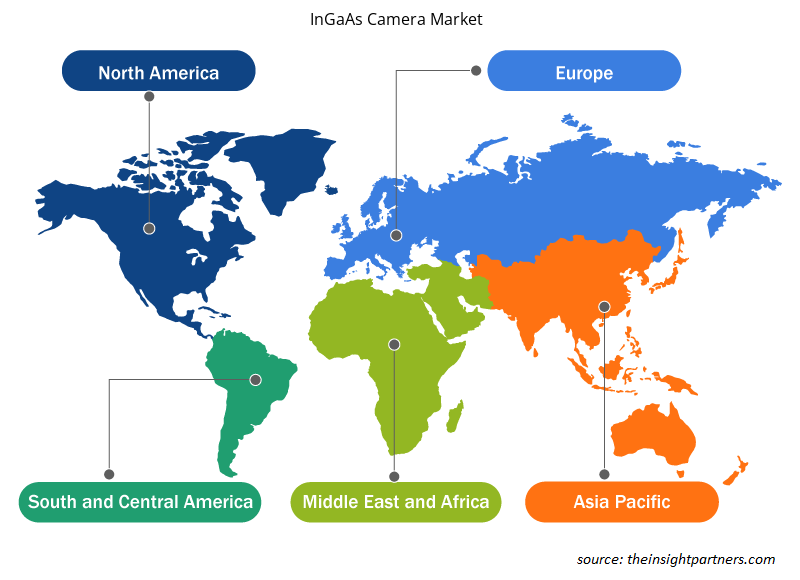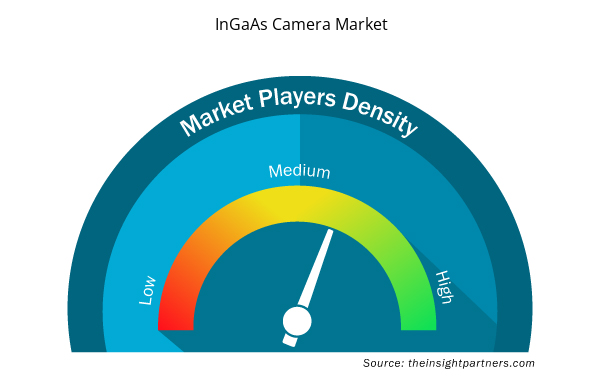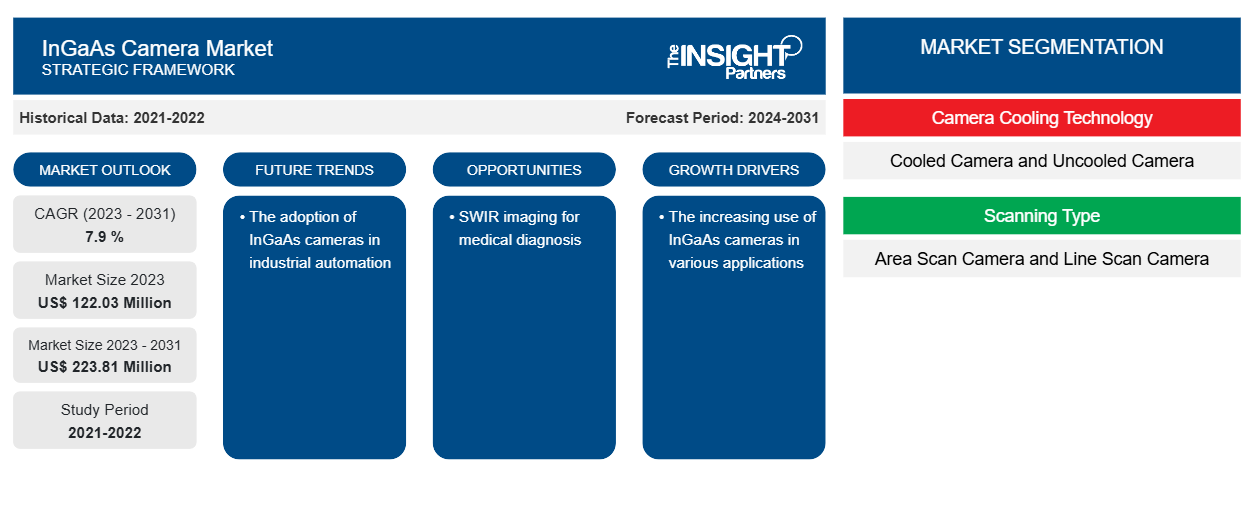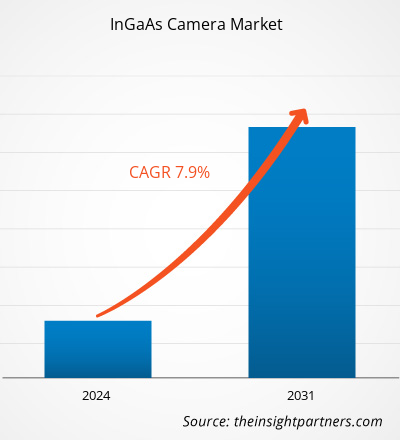من المتوقع أن يصل حجم سوق كاميرات InGaAs إلى 223.81 مليون دولار أمريكي بحلول عام 2031 من 122.03 مليون دولار أمريكي في عام 2023. ومن المتوقع أن يسجل السوق معدل نمو سنوي مركب بنسبة 7.9٪ خلال الفترة 2023-2031. ومن المرجح أن يظل اعتماد كاميرات InGaAs في الأتمتة الصناعية اتجاهًا رئيسيًا في السوق.
تحليل سوق كاميرات InGaAs
يُعزى نمو سوق كاميرات InGaAs إلى الاستخدام المتزايد لهذه الكاميرات في تطبيقات مختلفة، مثل الأتمتة الصناعية والتشخيص الطبي . يمكن لكاميرا SWIR منع ذلك وبالتالي ضمان عملية إنتاج سلسة. لذلك، فإن زيادة استخدام كاميرات InGaAs في تطبيقات مختلفة هي التي تقود سوق كاميرات InGaAs. تتم أيضًا مناقشة تقنيات التصوير SWIR، مثل التصوير الطيفي الفائق SWIR للتطبيقات الطبية الحيوية ونظام المجهر الرقمي ثلاثي الأبعاد عريض النطاق (VIS + SWIR) القائم على مستشعر صور النقاط الكمومية (QD) الجديد. وبالتالي، فإن زيادة استخدام كاميرات InGaAs في تطبيقات مختلفة هي التي تقود السوق.
نظرة عامة على سوق كاميرات InGaAs
تُستخدم أجهزة استشعار InGaAs في العلوم الفيزيائية وعلوم الحياة وتتطلب حساسية عالية على مدى طول موجي يتراوح بين 900 و1700 نانومتر، والمعروف باسم الأشعة تحت الحمراء ذات الموجات القصيرة (SWIR). يمكن لبعض أجهزة استشعار InGaAs قياس ما يصل إلى 2500 نانومتر بسبب التغيرات في تركيب المادة. على الرغم من أن كاميرات CCD القائمة على السيليكون تمتلك حساسية على مدى الأشعة فوق البنفسجية إلى الأشعة تحت الحمراء القريبة، فإن خصائص الفجوة النطاقية للسيليكون تمنع هذه الأجهزة من الحصول على حساسية كافية على مدى 1100 نانومتر. تتمتع كاميرات InGaAs بفجوة نطاقية أقل، مما يجعل هذه المادة المادة المفضلة للتطبيقات في منطقة الأشعة تحت الحمراء ذات الموجات القصيرة (SWIR).
قم بتخصيص هذا التقرير ليناسب متطلباتك
ستحصل على تخصيص لأي تقرير - مجانًا - بما في ذلك أجزاء من هذا التقرير، أو تحليل على مستوى الدولة، وحزمة بيانات Excel، بالإضافة إلى الاستفادة من العروض والخصومات الرائعة للشركات الناشئة والجامعات
- احصل على أهم اتجاهات السوق الرئيسية لهذا التقرير.ستتضمن هذه العينة المجانية تحليلاً للبيانات، بدءًا من اتجاهات السوق وحتى التقديرات والتوقعات.
محركات وفرص سوق كاميرات InGaAs
الاستخدام المتزايد لكاميرات InGaAs في تطبيقات مختلفة
يعد فحص بلورات وسبائك السيليكون (المعروفة أيضًا باسم الطوب) أحد أكثر التطبيقات شيوعًا لكاميرات InGaAs في قطاع أشباه الموصلات. توفر القدرة على الرؤية في السيليكون عند نطاق الطول الموجي أعلى من 1150 نانومتر لكاميرات InGaAs حلاً مناسبًا للكشف عن الشوائب، مثل الشوائب داخل البلورة أو السبائك، والتي يمكن أن تتجمع أثناء عملية الإنتاج. تكون الشوائب بالغة الأهمية عند مراقبة السبائك في رقائق رقيقة بسلسلة من الماس. إذا ضربت السلسلة عنصرًا، مثل قطعة صغيرة من المعدن، فقد تنكسر السلسلة باهظة الثمن بشكل استثنائي. لا يؤدي استبدال السلسلة إلى توليد تكلفة فحسب، بل يؤدي أيضًا إلى انخفاض الإنتاجية وانخفاض الأرباح. يمكن لكاميرا SWIR منع ذلك وبالتالي ضمان عملية إنتاج سلسة. لذلك، فإن زيادة استخدام كاميرات InGaAs في تطبيقات مختلفة هو محرك سوق كاميرات InGaAs.
التصوير بالأشعة تحت الحمراء القصيرة المدى للتشخيص الطبي
تُستخدم تقنية التصوير بالأشعة تحت الحمراء القصيرة في التشخيص الطبي. وتتناول هذه التقنية تطوير تقنيات تعتمد على ضوء الأشعة تحت الحمراء القصيرة، بما في ذلك تصنيع واستخدام جسيمات الأشعة تحت الحمراء القصيرة كعوامل حرارية ضوئية ومقاييس حرارة نانوية مضيئة، والتطورات الأخيرة في البنية والتصميم والتطبيقات الطبية الحيوية المرتبطة بالأشعة تحت الحمراء القصيرة للجسيمات النانوية المخدرة بالعناصر النادرة (REDNs). وتعتبر الجسيمات النانوية المخدرة بالعناصر النادرة من بين أكثر أجهزة إصدار الأشعة تحت الحمراء القصيرة سطوعًا وتوافقًا حيويًا. كما تتم مناقشة تقنيات التصوير بالأشعة تحت الحمراء القصيرة، مثل التصوير الطيفي الفائق للأشعة تحت الحمراء القصيرة للتطبيقات الطبية الحيوية ونظام المجهر الرقمي ثلاثي الأبعاد عريض النطاق (VIS+SWIR) القائم على مستشعر صور النقاط الكمومية (QD) الجديد. وبالتالي، فإن زيادة استخدام كاميرات InGaAs في تطبيقات مختلفة هي التي تدفع السوق.
تقرير تحليل تجزئة سوق كاميرات InGaAs
كانت القطاعات الرئيسية التي ساهمت في اشتقاق تحليل سوق كاميرا InGaAs هي تقنية تبريد الكاميرا ونوع المسح والتطبيق.
- استنادًا إلى تقنية تبريد الكاميرا، ينقسم سوق كاميرات InGaAs إلى كاميرات مبردة وكاميرات غير مبردة. احتل قطاع البرامج حصة سوقية أكبر في عام 2023.
- بحسب نوع المسح، يتم تقسيم السوق إلى كاميرات مسح المنطقة وكاميرات المسح الخطي.
- حسب التطبيق، يتم تقسيم السوق إلى العسكرية والدفاعية، والأتمتة الصناعية، والبحث العلمي.
تحليل حصة سوق كاميرات InGaAs حسب المنطقة الجغرافية
ينقسم النطاق الجغرافي لتقرير سوق كاميرا InGaAs بشكل أساسي إلى خمس مناطق: أمريكا الشمالية، ومنطقة آسيا والمحيط الهادئ، وأوروبا، والشرق الأوسط وأفريقيا، وأمريكا الجنوبية والوسطى.
تهيمن منطقة آسيا والمحيط الهادئ على سوق كاميرات InGaAs. ومن المتوقع أن يؤدي الطلب المتزايد على تبني الأتمتة في الصناعات والاختبارات غير المدمرة والاعتماد المتزايد على تطبيقات الرؤية الآلية إلى دفع نمو سوق كاميرات InGaAs خلال الفترة المتوقعة.
نظرة إقليمية على سوق كاميرات InGaAs
لقد قام المحللون في Insight Partners بشرح الاتجاهات والعوامل الإقليمية المؤثرة على سوق كاميرات InGaAs طوال فترة التوقعات بشكل شامل. يناقش هذا القسم أيضًا قطاعات سوق كاميرات InGaAs والجغرافيا في جميع أنحاء أمريكا الشمالية وأوروبا ومنطقة آسيا والمحيط الهادئ والشرق الأوسط وأفريقيا وأمريكا الجنوبية والوسطى.

- احصل على البيانات الإقليمية المحددة لسوق كاميرات InGaAs
نطاق تقرير سوق كاميرات InGaAs
| سمة التقرير | تفاصيل |
|---|---|
| حجم السوق في عام 2023 | 122.03 مليون دولار أمريكي |
| حجم السوق بحلول عام 2031 | 223.81 مليون دولار أمريكي |
| معدل النمو السنوي المركب العالمي (2023 - 2031) | 7.9% |
| البيانات التاريخية | 2021-2022 |
| فترة التنبؤ | 2024-2031 |
| القطاعات المغطاة | بواسطة تقنية تبريد الكاميرا
|
| المناطق والدول المغطاة | أمريكا الشمالية
|
| قادة السوق وملفات تعريف الشركات الرئيسية |
|
كثافة اللاعبين في السوق: فهم تأثيرها على ديناميكيات الأعمال
يشهد سوق كاميرات InGaAs نموًا سريعًا، مدفوعًا بالطلب المتزايد من المستخدم النهائي بسبب عوامل مثل تفضيلات المستهلك المتطورة والتقدم التكنولوجي والوعي الأكبر بفوائد المنتج. ومع ارتفاع الطلب، تعمل الشركات على توسيع عروضها والابتكار لتلبية احتياجات المستهلكين والاستفادة من الاتجاهات الناشئة، مما يؤدي إلى زيادة نمو السوق.
تشير كثافة اللاعبين في السوق إلى توزيع الشركات أو المؤسسات العاملة في سوق أو صناعة معينة. وهي تشير إلى عدد المنافسين (اللاعبين في السوق) الموجودين في مساحة سوق معينة نسبة إلى حجمها أو قيمتها السوقية الإجمالية.
الشركات الرئيسية العاملة في سوق كاميرات InGaAs هي:
- فوتونيكس هاماماتسو كيه كيه
- شركة Allied Vision Technologies GmbH
- تقنيات التصوير الجديدة
- شركة بيمبروك للأدوات المحدودة
- شركة بوليتيك المحدودة
- شركة رابتور فوتونيكس المحدودة
إخلاء المسؤولية : الشركات المذكورة أعلاه ليست مرتبة بأي ترتيب معين.

- احصل على نظرة عامة على أهم اللاعبين الرئيسيين في سوق كاميرات InGaAs
أخبار سوق الكاميرات في InGaAs والتطورات الأخيرة
يتم تقييم سوق كاميرات InGaAs من خلال جمع البيانات النوعية والكمية بعد البحث الأولي والثانوي، والذي يتضمن منشورات الشركات المهمة وبيانات الجمعيات وقواعد البيانات. فيما يلي بعض التطورات في سوق كاميرات InGaAs:
- قدمت شركة Hamamatsu Photonics، وهي شركة رائدة في توفير أحدث التقنيات والمنتجات الفوتونية، كاميرا InGaAs جديدة ذات حساسية في المنطقة المرئية إلى الأشعة تحت الحمراء القريبة من 400 نانومتر إلى 1700 نانومتر. (المصدر: Hamamatsu Photonics، بيان صحفي، فبراير 2024.)
- أطلقت شركة BlueVision Ltd.، اليابان، كاميرا مسح خطية جديدة بدقة 1K SWIR تسمى BV-C3110، وهي مستشعر InGaAs جديد تمامًا بدقة 1K في أبريل 2021 (المصدر: BlueVision Ltd، بيان صحفي، أبريل 2021)
تقرير سوق كاميرات InGaAs والتغطية والمخرجات
يوفر تقرير "حجم سوق كاميرات InGaAs والتوقعات (2021-2031)" تحليلاً مفصلاً للسوق يغطي المجالات التالية:
- حجم سوق كاميرات InGaAs وتوقعاته على المستويات العالمية والإقليمية والوطنية لجميع قطاعات السوق الرئيسية المغطاة ضمن النطاق
- اتجاهات سوق الكاميرات في InGaAs، بالإضافة إلى ديناميكيات السوق مثل المحركات والقيود والفرص الرئيسية
- تحليل مفصل لقوى PEST/Porter الخمس وSWOT
- تحليل سوق كاميرات InGaAs يغطي اتجاهات السوق الرئيسية والإطار العالمي والإقليمي واللاعبين الرئيسيين واللوائح والتطورات الأخيرة في السوق
- تحليل المشهد الصناعي والمنافسة الذي يغطي تركيز السوق، وتحليل خريطة الحرارة، واللاعبين البارزين، والتطورات الأخيرة لسوق كاميرا InGaAs
- ملفات تعريف الشركة التفصيلية
- التحليل التاريخي (سنتان)، السنة الأساسية، التوقعات (7 سنوات) مع معدل النمو السنوي المركب
- تحليل PEST و SWOT
- حجم السوق والقيمة / الحجم - عالميًا وإقليميًا وقطريًا
- الصناعة والمنافسة
- مجموعة بيانات Excel


- Artificial Intelligence in Defense Market
- Toothpaste Market
- Visualization and 3D Rendering Software Market
- Medical Enzyme Technology Market
- Travel Vaccines Market
- Fill Finish Manufacturing Market
- Airport Runway FOD Detection Systems Market
- Skin Tightening Market
- Medical and Research Grade Collagen Market
- Digital Pathology Market

Report Coverage
Revenue forecast, Company Analysis, Industry landscape, Growth factors, and Trends

Segment Covered
This text is related
to segments covered.

Regional Scope
North America, Europe, Asia Pacific, Middle East & Africa, South & Central America

Country Scope
This text is related
to country scope.
الأسئلة الشائعة
The expected CAGR of the global InGaAs camera market is 7.9 %.
The global InGaAs camera market is expected to reach US$ 223.81 million by 2031.
The adoption of InGaAs cameras in industrial automation is anticipated to play a significant role in the global InGaAs camera market in the coming years.
The key players holding majority shares in the global InGaAs camera market are Hamamatsu Photonics K.K., Allied Vision Technologies GmbH, New Imaging Technologies, Pembroke Instruments, LLC, Polytec GmbH, Raptor Photonics Limited, Sensors Unlimited, SWIR Vision Systems Inc., Xenics nv., and Seiwa Optical America Inc.
APAC dominates the InGaAs camera market.
The increasing use of InGaAs cameras in various applications and SWIR imaging for medical diagnosis are the major factors that propel the global InGaAs camera market.
Trends and growth analysis reports related to Electronics and Semiconductor : READ MORE..
The Insight Partners performs research in 4 major stages: Data Collection & Secondary Research, Primary Research, Data Analysis and Data Triangulation & Final Review.
- Data Collection and Secondary Research:
As a market research and consulting firm operating from a decade, we have published and advised several client across the globe. First step for any study will start with an assessment of currently available data and insights from existing reports. Further, historical and current market information is collected from Investor Presentations, Annual Reports, SEC Filings, etc., and other information related to company’s performance and market positioning are gathered from Paid Databases (Factiva, Hoovers, and Reuters) and various other publications available in public domain.
Several associations trade associates, technical forums, institutes, societies and organization are accessed to gain technical as well as market related insights through their publications such as research papers, blogs and press releases related to the studies are referred to get cues about the market. Further, white papers, journals, magazines, and other news articles published in last 3 years are scrutinized and analyzed to understand the current market trends.
- Primary Research:
The primarily interview analysis comprise of data obtained from industry participants interview and answers to survey questions gathered by in-house primary team.
For primary research, interviews are conducted with industry experts/CEOs/Marketing Managers/VPs/Subject Matter Experts from both demand and supply side to get a 360-degree view of the market. The primary team conducts several interviews based on the complexity of the markets to understand the various market trends and dynamics which makes research more credible and precise.
A typical research interview fulfils the following functions:
- Provides first-hand information on the market size, market trends, growth trends, competitive landscape, and outlook
- Validates and strengthens in-house secondary research findings
- Develops the analysis team’s expertise and market understanding
Primary research involves email interactions and telephone interviews for each market, category, segment, and sub-segment across geographies. The participants who typically take part in such a process include, but are not limited to:
- Industry participants: VPs, business development managers, market intelligence managers and national sales managers
- Outside experts: Valuation experts, research analysts and key opinion leaders specializing in the electronics and semiconductor industry.
Below is the breakup of our primary respondents by company, designation, and region:

Once we receive the confirmation from primary research sources or primary respondents, we finalize the base year market estimation and forecast the data as per the macroeconomic and microeconomic factors assessed during data collection.
- Data Analysis:
Once data is validated through both secondary as well as primary respondents, we finalize the market estimations by hypothesis formulation and factor analysis at regional and country level.
- Macro-Economic Factor Analysis:
We analyse macroeconomic indicators such the gross domestic product (GDP), increase in the demand for goods and services across industries, technological advancement, regional economic growth, governmental policies, the influence of COVID-19, PEST analysis, and other aspects. This analysis aids in setting benchmarks for various nations/regions and approximating market splits. Additionally, the general trend of the aforementioned components aid in determining the market's development possibilities.
- Country Level Data:
Various factors that are especially aligned to the country are taken into account to determine the market size for a certain area and country, including the presence of vendors, such as headquarters and offices, the country's GDP, demand patterns, and industry growth. To comprehend the market dynamics for the nation, a number of growth variables, inhibitors, application areas, and current market trends are researched. The aforementioned elements aid in determining the country's overall market's growth potential.
- Company Profile:
The “Table of Contents” is formulated by listing and analyzing more than 25 - 30 companies operating in the market ecosystem across geographies. However, we profile only 10 companies as a standard practice in our syndicate reports. These 10 companies comprise leading, emerging, and regional players. Nonetheless, our analysis is not restricted to the 10 listed companies, we also analyze other companies present in the market to develop a holistic view and understand the prevailing trends. The “Company Profiles” section in the report covers key facts, business description, products & services, financial information, SWOT analysis, and key developments. The financial information presented is extracted from the annual reports and official documents of the publicly listed companies. Upon collecting the information for the sections of respective companies, we verify them via various primary sources and then compile the data in respective company profiles. The company level information helps us in deriving the base number as well as in forecasting the market size.
- Developing Base Number:
Aggregation of sales statistics (2020-2022) and macro-economic factor, and other secondary and primary research insights are utilized to arrive at base number and related market shares for 2022. The data gaps are identified in this step and relevant market data is analyzed, collected from paid primary interviews or databases. On finalizing the base year market size, forecasts are developed on the basis of macro-economic, industry and market growth factors and company level analysis.
- Data Triangulation and Final Review:
The market findings and base year market size calculations are validated from supply as well as demand side. Demand side validations are based on macro-economic factor analysis and benchmarks for respective regions and countries. In case of supply side validations, revenues of major companies are estimated (in case not available) based on industry benchmark, approximate number of employees, product portfolio, and primary interviews revenues are gathered. Further revenue from target product/service segment is assessed to avoid overshooting of market statistics. In case of heavy deviations between supply and demand side values, all thes steps are repeated to achieve synchronization.
We follow an iterative model, wherein we share our research findings with Subject Matter Experts (SME’s) and Key Opinion Leaders (KOLs) until consensus view of the market is not formulated – this model negates any drastic deviation in the opinions of experts. Only validated and universally acceptable research findings are quoted in our reports.
We have important check points that we use to validate our research findings – which we call – data triangulation, where we validate the information, we generate from secondary sources with primary interviews and then we re-validate with our internal data bases and Subject matter experts. This comprehensive model enables us to deliver high quality, reliable data in shortest possible time.


 احصل على عينة مجانية لهذا التقرير
احصل على عينة مجانية لهذا التقرير